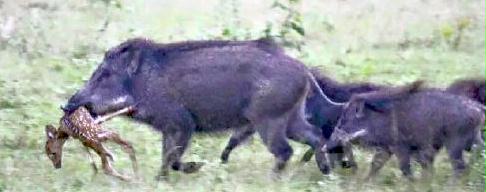
Preface. The Decline category used to be Death By A Thousand Cuts. Feral hogs are yet another cut for anyone who survives peak oil. Not only will climate change be drastically cutting back food production, feral hogs will too, and potentially spread disease to livestock.
Alice Friedemann www.energyskeptic.com author of “When Trucks Stop Running: Energy and the Future of Transportation”, 2015, Springer, Barriers to Making Algal Biofuels, and “Crunch! Whole Grain Artisan Chips and Crackers”. Podcasts: Derrick Jensen, Practical Prepping, KunstlerCast 253, KunstlerCast278, Peak Prosperity , XX2 report
***
Robbins, J. 2019. Feral Pigs Roam the South. Now Even Northern States Aren’t Safe. The swine have established themselves in Canada and are encroaching on border states like Montana and North Dakota. New York Times.
Feral pigs are widely considered to be the most destructive invasive species in the United States. They can do remarkable damage to the ecosystem, wrecking crops and hunting animals like birds and amphibians to near extinction. They have wrecked military planes on runways.
The swine are also reservoirs for at least 32 diseases, including bovine tuberculosis, brucellosis and leptospirosis. Outbreaks of E. coli in spinach and lettuce have been blamed on feral hogs defecating in farm fields.
There are reports that people have contracted hepatitis and brucellosis from butchering the animals after hunting.
If an animal disease like African swine fever or hoof-and-mouth gets into these animals, it will be almost impossible to stop. It will shut down our livestock industry.
In the United States, their stronghold is the South — about half of the nation’s six million feral pigs live in Texas. But in the past 30 years, the hogs have expanded their range to 38 states from 17.
Many experts thought the pigs couldn’t thrive in cold climates. But they burrow into the snow in winter, creating so-called pigloos — a tunnel or cave with a foot or two of snow on top for insulation. Many have developed thick coats of fur.
The damage in the United States is estimated to be $1.5 billion annually, but likely closer to $2.5 billion. Feral pigs don’t browse the landscape; they dig out plants by the root, and lots of them. Big hogs can chew up acres of crops in a single night, destroying pastures, tearing out fences, digging up irrigation systems, polluting water supplies.
They are very smart and can be very big — a Georgia pig called Hogzilla is believed to have weighed at least 800 pounds — and populations grow rapidly.
Pigs will literally eat anything. They eat ground-nesting birds — eggs and young and adults. They eat frogs. They eat salamanders. They are huge on insect larvae. I’ve heard of them taking adult white-tailed deer. A recent study found that mammal and bird communities are 26 percent less diverse in forests where feral pigs are present. Sea turtles are an especially egregious example.

3 Responses to Invasion of feral hogs yet another hazard for the future